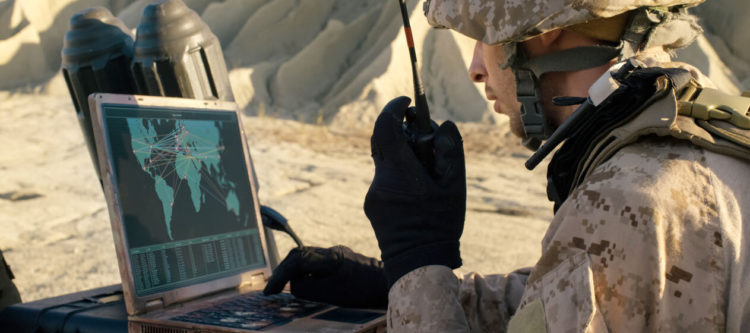Discussions at C4ISRNET Conference show need for resilient, dependable comms

As the U.S. military faces increasingly sophisticated threats, they need reliable and secure networks that can deliver increased capability and functionality, realtime intelligence, and up-to-the-minute situational awareness to every warfighter, regardless of their location or which domain they’re operating in. This requirement has been the impetus for ongoing Department of Defense (DoD) network upgrade and interoperability initiatives, which aim to deliver actionable intelligence to military decision-makers when and where they need it, and to connect sensors to shooters across the force.
The need for resilient, interoperable, and assured communications was a key focus of the recent C4ISRNET annual conference, which sought to bring together military leaders and industry experts to discuss cybersecurity, communications, command and control, and other best practices at what is considered an incredibly important inflection point for our military. But one panel discussion – and one comment in particular – really caught my attention at this year’s event.
Only useful if we can use it
We’ve all had the experience of purchasing an exciting and innovative piece of technology or equipment for an elderly loved one, only to have it sit unused and unappreciated on a shelf or in a closet. While our intentions were good and that device or appliance would really have made their life better, a lack of understanding of how to operate the device led to it being ignored and discarded.
Ultimately, it doesn’t matter how much capability or functionality a new technology has – it doesn’t matter how much it will improve our lives or our jobs – if we can’t use it. And that’s exactly what the military might have to deal with when it comes to their advanced networks and network-connected devices.
“There will still, no matter what we do, be times when we will either choose to be disconnected, or we will be disconnected outside of our own choices.” –Yeske
In a side session at the C4ISRNET Conference entitled, “Next-Generation Networks,” Don Yeske, the Chief Technology Officer for the Department of the Navy, shared the DoD’s vision for next-generation networks and how new technologies are helping to bring that vision to life.
During this session, Yeske mentioned game-changing technologies such as Lower Earth Orbit (LEO) satellite services that can deliver high-throughput, low-latency connectivity for the military to practically anywhere on the planet. And while there is tremendous excitement for these solutions and the game-changing potential they could have for military operations, Yeske also reminded everyone in attendance of a cold, hard truth about these technologies – the military will invariably find itself in situations where it has to operate without them.
According to Yeske, “There will still, no matter what we do, be times when we will either choose to be disconnected, or we will be disconnected outside of our own choices.”
Though LEO communications can be beneficial for the DoD, satellite service may not always be available. For example, as the Russia-Ukraine War has waged on, Russia has learned to locate and jam Ukrainian soldiers using StarLink satellite terminals. This is not the first and only threat to Ukraine’s use of the SpaceX LEO constellation. Outages were previously reported as Ukraine’s counteroffensive moved into Russian-occupied territory. In this instance, there was speculation that SpaceX – and its mercurial leader, Elon Musk – may have been restricting access.
Today’s military relies heavily on connected sensors for ISR and situational awareness. It also has embraced many network-enabled and connected military platforms and systems that are foundational for warfighting. Connectivity is essential, and the military needs to be prepared to operate without these new communications solutions in those situations that Yeske eloquently described as, “…times…when we will either choose to be disconnected, or we will be disconnected outside of our own choices.”
Mobile mesh – practically undeniable
It’s clear that today’s military needs a communications tool that can deliver mission-critical connectivity and situational awareness even when advanced communications solutions – such as LEO satellite networks – are denied or otherwise unavailable. They also need a way to extend the connectivity delivered by their 5G and satellite services while making their networks both more resilient and redundant.
But how can the DoD mitigate communication risks and better prepare themselves for these challenges? Mobile mesh networking could offer a solution.
“Once established, a mobile mesh network could be used to enable basic text-communication between warfighters. It can be used in conjunction with the ATAK application to share information and to see the location of all allied units on a map for improved situational awareness…”
Mobile mesh can be used for basic communications and situational awareness when LEO satellites and other networks are unavailable or denied by an adversary. These networks can be established simply by connecting mobile mesh networking nodes or radios to mobile devices via Bluetooth or cable, creating an ad-hoc network almost instantaneously, when needed.
Mobile mesh networks can effectively connect all devices in a large geographic region together so that they can communicate amongst themselves. But it can also do much more than that. Mobile mesh can be used to extend connectivity from satellite or terrestrial networks to other devices in the area – effectively enabling information to flow back to senior leaders and decision-makers that need it.
Also, since there is no central hub or infrastructure required for a mobile mesh network, they’re incredibly difficult to deny or degrade. Each radio receives and transmits a signal, effectively creating a self-healing network with no single point of failure. Any one radio or relay that is denied or destroyed can easily be replaced, or other nodes will function to take its place in the network.
Once established, a mobile mesh network could be used to enable basic text-communication between warfighters. It can be used in conjunction with the ATAK application to share information and to see the location of all allied units on a map for improved situational awareness. It could even be leveraged to transmit some basic sensor and IoT device data. These are all use cases and capabilities that could be essential for successful, coordinated military missions with warfighters from disparate services and even allied nations.
As Don Yeske established, there will be times when even the most advanced, high-bandwidth networks are unavailable for our military. Mobile mesh networking is a rapidly-deployed, difficult-to-deny solution for maintaining basic communications and situational awareness when other networks are unavailable, degraded, or denied.









No Comment